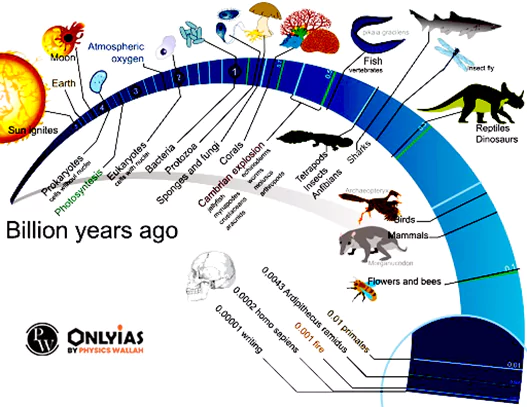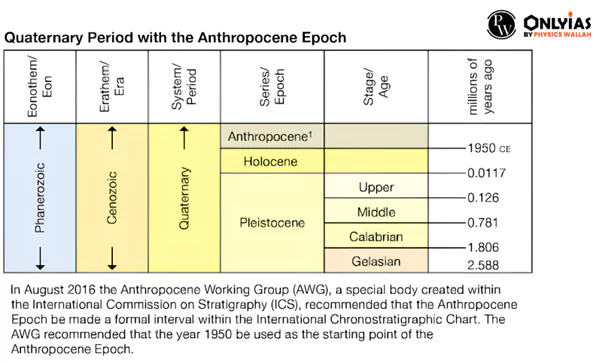Introduction of Formation of Earth: A Billion-Year Geological Saga #
The geological history of the Earth is a vast and intricate narrative that spans billions of years. It encompasses the formation of our planet, the evolution of continents and oceans, the emergence of life, and the shaping of the Formation of Earth through geological processes.
This history is marked by dramatic events, including the collision that created the Moon, the development of continents, and the rise and fall of species.
Formation of Earth Story: From Dust to Oceans, Extinctions, and Ice Ages #
- Formation of Earth:
- Approximately 4.54 billion years ago, Earth formed from dust and gas swirling around the young Sun.
- Early Earth was a molten mass with a formation of Earth continually bombarded by meteorites and comets.
- Moon’s Formation:
- Around 4.54 billion years ago, a Mars-sized body collided with the young Earth, partially liquefying its formation of Earth and ejecting molten debris into space.
- This ejected material coalesced to form the Moon, which remained as a ring around Earth before taking its current form.
- The Late Heavy Bombardment:
- Residual gases in the early solar system created space currents, influencing the movement of massive Jupiter, causing it to migrate toward the Sun.
- Jupiter’s gravitational influence dislodged asteroids, initiating a period of intense asteroid bombardment known as the Late Heavy Bombardment, impacting Earth and other terrestrial planets.
- Saturn’s Influence and Solar Wind:
- Saturn’s gravitational pull eventually restrained Jupiter, returning it to its current position.

-
- Simultaneously, the solar wind stripped away the remaining gas in the solar system, sending it into interstellar space.
- Water Delivery and Volcanic Activity:
- Formation of Earth, still cooling from the Moon’s formation, endured continuous bombardment and remained volcanically active.
- Asteroids or comets containing water ice later collided with Formation of Earth, contributing water vapour to the planet.
- As Formation of Earth cooled, the vapour condensed and fell as rain, forming oceans.
- Ongoing Volcanic Activity:
- Volcanic activity persisted, with lava flowing on the Formation of Earth for nearly 700 million years.
- Rocks, through their layers and composition, hold a record of Formation of Earth geological history.
- Early Atmosphere and Supercontinents:
- The early atmosphere was heavy, toxic, and devoid of free oxygen, with high levels of carbon dioxide, nitrogen, and sulphur due to volcanic activity.
- Within half a million years, multiple small land masses formed and served as the foundations for future continents.
- The oldest known rocks on Earth, found in Australia, date back to 4.4 billion years ago.
- Two supercontinents, Vaalbara and Ur, appeared around 3.5 billion years ago.
- The Emergence of Life:
- Despite the lack of oxygen in the atmosphere, life began in the early Precambrian, around 4.1 billion years ago.
- Specific zircons from this time period suggest biological activity combined with water presence.
- The presence of large oceans, facilitated by liquid water’s unique properties, was crucial for the emergence of life.
- The Oxygenation of Earth:
- Banded iron formations, dating back to 3.7 billion years ago, indicate periodic oxygenation of water, attributed to biological processes.
- Stromatolites, formed by microorganisms trapping sand grains, date to 3.5 billion years ago.
- Evidence of photosynthesis emerged around 2.4 billion years ago, with cyanobacteria releasing significant oxygen into the atmosphere.
- Formation of Earth’s atmosphere finally contained a stable supply of oxygen.
- Supercontinent Cycles and the Great Oxygenation Event:
- Kenorland, a new supercontinent, formed as Vaalbara broke apart, impacting Formation of Earth geography.
- The Great Oxygenation Event, 2.3 billion years ago, led to elevated oxygen levels, which caused the first extinction event and initiated the first ice age.
- Mass extinctions occurred as the climate changed rapidly due to the oxygen increase.
- The rise of oxygen reduced greenhouse gases, leading to lower temperatures and heralding an ice age.
- Ice ages are characterised by alternating glaciation periods and inter-glaciation periods, impacting Formation of Earth climate over millions of years.
Mass Extinction:
Historical Mass Extinctions:
|
Formation of Earth Timeline: Stratigraphy, Fossils, and the Geological Time Scale #
- The field of geology known as Stratigraphy studies and dates rock layers, offering insights into Formation of Earth history.
- Hierarchical Structure:
- The geological time scale is hierarchical, with units of time organised in descending order of duration.
- These units include eons, eras, periods, epochs, and ages.

- Stratigraphy and Fossils:
- The primary basis for the geological time scale is stratigraphy, which involves the study of rock layers and their sequences.
- Fossils found in rocks play a crucial role in establishing the time scale.
- The appearance and disappearance of specific fossil species help define and refine the boundaries between different time units.
- Key Time Units:
- Eon: The largest division of time, encompassing billions of years.
- The Phanerozoic, Proterozoic, Archean, and Hadean are the four eons that make up Formation of Earth geological history.
- Era: Eons are subdivided into eras, each characterised by distinct geological and biological events.
- The Phanerozoic Eon, for example, includes the Paleozoic, Mesozoic, and Cenozoic eras.
- Period: Eras are further divided into periods, marked by notable changes in Formation of Earth history.
- For example, the Cenozoic Era is divided into the Paleogene, Neogene, and Quaternary periods.
- Epoch: Periods are divided into epochs, representing shorter intervals of time.
- The Pleistocene epoch, for instance, is known for the last ice age.
- Age: The smallest time unit within the geological time scale.
- Ages are characterised by specific events and often correspond to the duration of a particular species’ existence.
- Eon: The largest division of time, encompassing billions of years.
| The Meghalayan Age: A Geological Epoch Shaped by Climate and Cultural Shifts
It is a relatively recent addition to the geological time scale, marking a distinct period in Formation of Earth history. Definition:
Holocene Epoch:
Major Climatic Event:
Cultural and Environmental Impact:
Note:
|

 GS Foundation
GS Foundation Crash Course
Crash Course Combo
Combo Optional Courses
Optional Courses Degree Program
Degree Program












